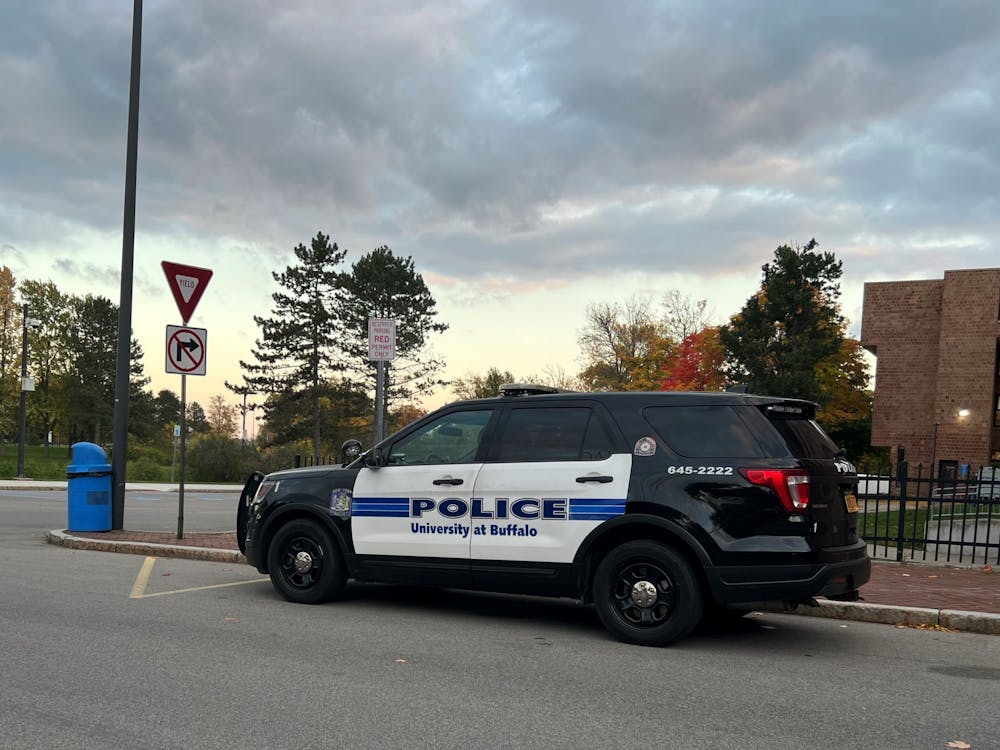Fifteen University Police officers used force a total of 24 times in connection with nine incidents during the 2021-22 academic year, according to UPD use of force reports obtained by The Spectrum through Freedom of Information Law requests. The reports were redacted to omit the identities and personal information of those involved.
Uses of force only included the use of handcuffs and “empty hand control,” which is when officers use their body to control a subject. Officers’ uses of “empty hand control” ranged from grabbing the arm of a student who was sitting on a ledge during a mental health call to “placing” a knee between someone’s shoulder blades “to maintain control” of them after police say they attempted to punch an officer.
Cases of officers using empty hand control have risen steadily from two cases in 2017 to seven in 2021. UPD Chief Deputy Josh Sticht says this is because the department has started recording all uses of force, not just major ones.
UPD officers only reported using force while in uniform and did not document any cases where they brandished or used batons, pepper spray or firearms during the last academic year.
One individual involved in a “violent domestic incident” complained of an injury after attempting to rush toward another individual the police were interviewing, according to use of force reports. Officers got into a physical altercation with the individual and applied handcuffs, which the individual broke out of. Officers reapplied handcuffs and wrote that they did not observe any injury and that the individual refused treatment. Two officers were injured — one was bitten on the hand during the aforementioned domestic incident and another officer reported an unspecified injury after taking an individual to the ground and handcuffing them during an attempted assault.
Student demographic information was redacted in copies of use of force reports viewed by The Spectrum, but according to UPD’s website, police used force against three white, three Black and two Asian American individuals during the 2021 calendar year. Of those eight individuals, five were men and three were women.
UPD responded to 21,611 calls in 2021. Data for spring 2022 was not available.
Officers are only permitted to use force that is “objectively reasonable under the circumstances, and reasonably believed to be necessary to achieve a lawful purpose” under UPD’s use of force policy. Factors that may determine “reasonableness” include the severity of the crime, the level and immediacy of threat, the potential for injury and the risk of escape, among others. Officers are also required to intervene if they see an officer using prohibited force, such as chokeholds or the use of force to coerce a confession.
Five of the nine cases where police used force were mental health calls, and police restrained an uncooperative, intoxicated individual for transportation to a hospital in four of those five.
The remaining cases included a violent “domestic incident,” a criminal mischief case, an attempted assault and a case where a student tried to flee from the police.
University Police apply the same standards of “reasonableness” to force in mental health calls that they apply to other kinds of cases, according to Sticht.
“The training that we do around use of force — like what kind of holds to use, what kinds of holds not to use — is pretty much the same whether somebody’s resisting us because they’re trying to get away from us because they committed a crime or because they’re a danger to themselves,” Sticht said.
Newly-recruited UPD officers undergo training at the Erie County Central Police Services Law Enforcement Academy, which includes a two-week course on defensive tactics like “compliance holds” and the proper use of handcuffs, batons and pepper spray.
“Any use of force is potentially dangerous, which is why we do so much training around it,” Sticht said. “We know that if we have to put a person in that position to take them into custody, we have to immediately — once the person’s under control — move them into a different position, move them into the recovery position, so they’re able to breathe and their blood’s able to circulate correctly.”
UPD will frequently send additional officers to scenes where force is used to avoid more extreme uses of force.
“Rather than using impact weapons or tasers or anything like that, our standard operating procedure is that we get more officers there to help with taking that person into custody safely,” Sticht said.
The use of force reports filled out by each officer are compiled and reviewed along with other documentation during each officers’ annual review, allowing UPD to identify officers who use force frequently and/or inappropriately.
“[We] try and get a whole picture,” Sticht said. “If there’s an issue, [We can] intercede before it gets to the point where somebody does something wrong.”
Grant Ashley is the managing editor and can be reached at grant.ashley@ubspectrum.com

Grant Ashley is the editor in chief of The Spectrum. He's also reported for NPR, WBFO, WIVB and The Buffalo News. He enjoys taking long bike rides, baking with his parents’ ingredients and recreating Bob Ross paintings in crayon. He can be found on the platform formerly known as Twitter at @Grantrashley.





